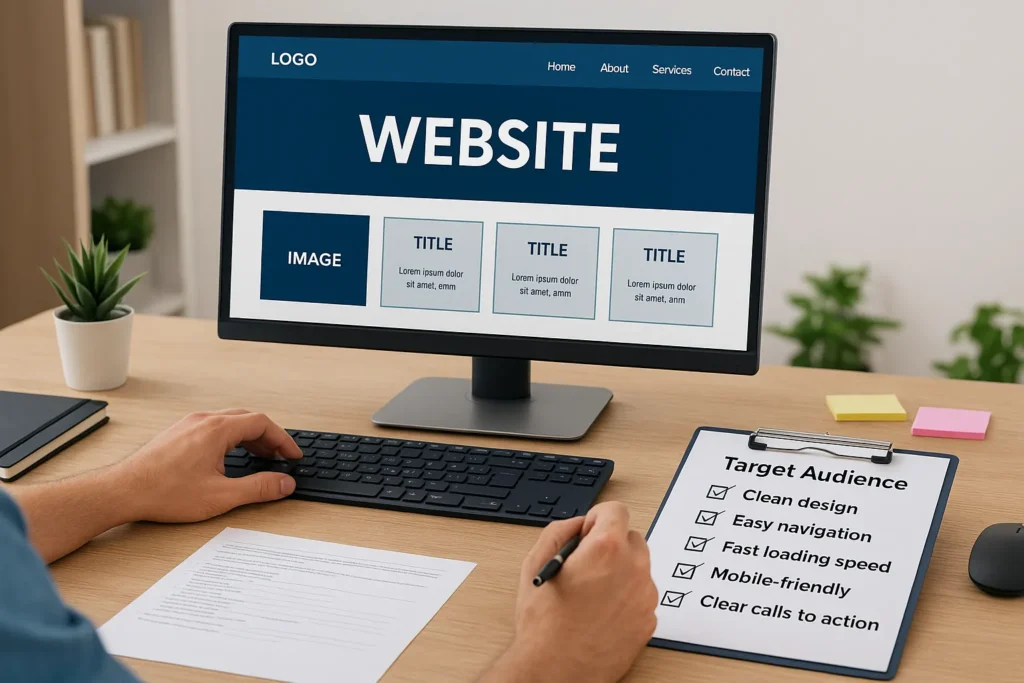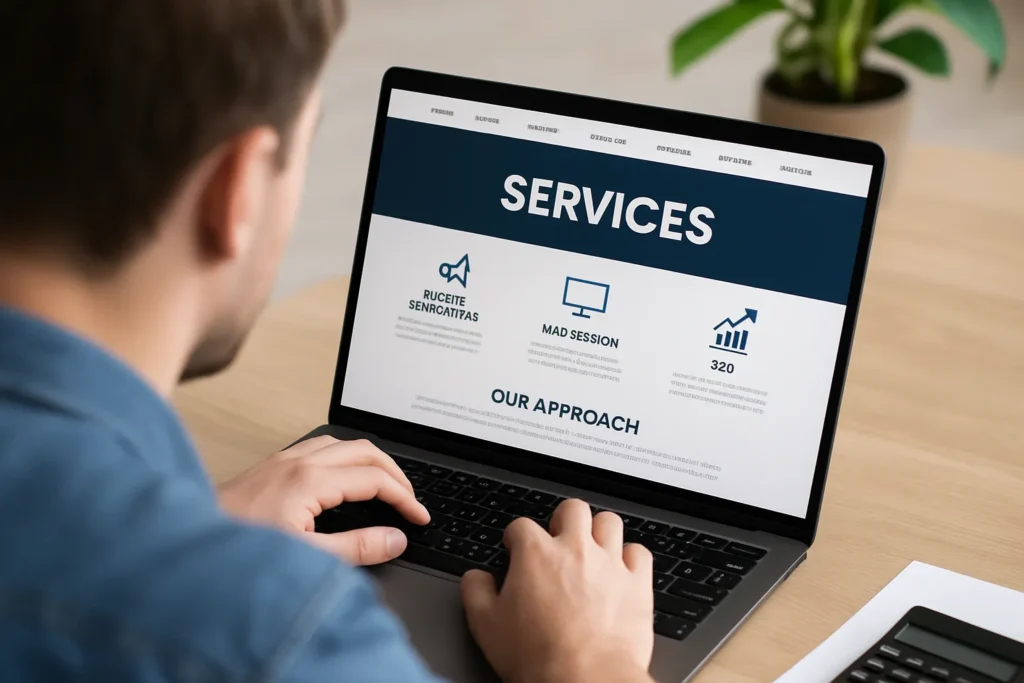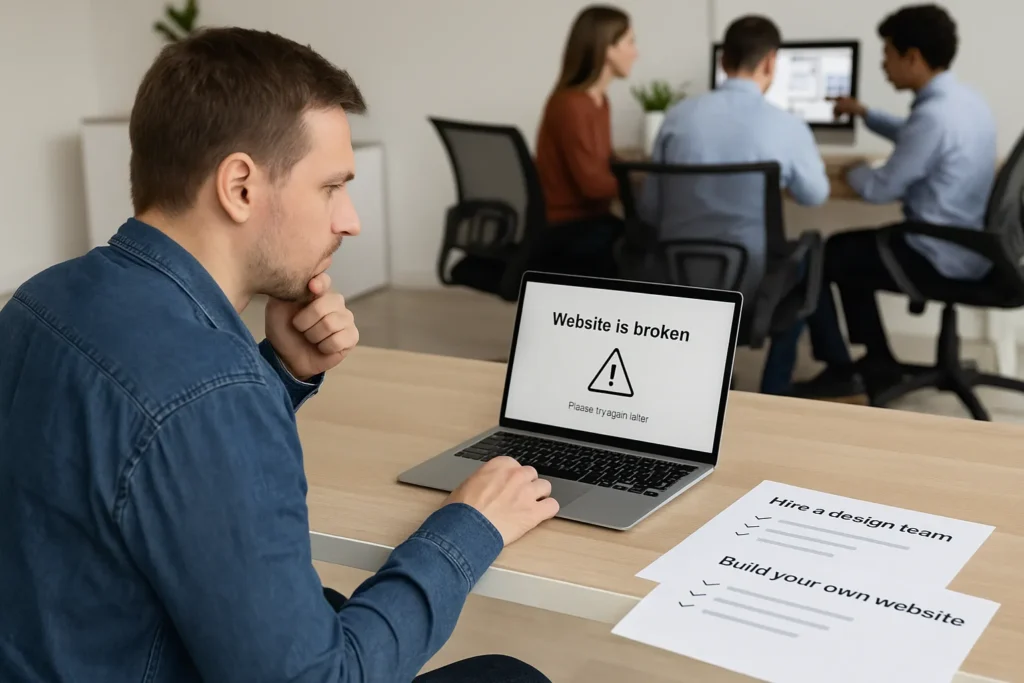Your website might be losing you money right now. The concern in this case is that most small business owners don’t realise how much an outdated site damages their reputation. People judge businesses in seconds, and if your website looks like it’s stuck in 2015, they’re already moving on to someone else. Yes, that’s the reality.
A fresh, functional website builds trust instantly and makes it easier for existing and potential customers to find what they need.
Throughout this article, you’ll see exactly what modern web design brings to the table and how it directly impacts your ability to attract and keep customers who are ready to spend.
Let’s talk about why upgrading matters and what it can do for your bottom line.
Modern Web Design Builds Trust With Your Target Audience
Here’s what happens when someone lands on your business website for the first time. They’re not reading your carefully built about page or checking out your services right away. They’re making snap judgments about whether you’re legitimate.

So, ask yourself: Does the site load quickly? Does it look professional? Can they find what they need without hunting through messy menus? If you answered “no” for two of these, there’s a good chance they will leave your website without even trying to understand what you offer.
Here’s an example to help break it down: think about two Brisbane cafes. One has a modern site with clear photos, easy online ordering, and current opening hours. The other has a clunky layout from 2012 with broken links and blurry images. Both might serve excellent coffee, but you already know which one feels more trustworthy.
Yes, your website speaks for you when you’re not there. It’s working (or not working) for your business 24/7. When existing and potential customers can scroll down the website smoothly, find information fast, and feel confident about what they’re seeing, they’re far more likely to pick up the phone or fill out that contact form.
What Makes a Small Business Website User-Friendly?
You’ve probably heard “user-friendly” thrown around a lot, but what does that actually mean for a small business website? It comes down to three things that directly affect whether people stick around or leave.
Fast Loading Speed Keeps Visitors Around
Your site needs to load in under three seconds. After that, you’re losing people. Google found that 53% of mobile users abandon sites that take longer than three seconds to load. That’s more than half your potential customers gone before they’ve seen anything. Terrible, isn’t it?
Mobile-First Design Reaches Customers Everywhere
Most people browse on their phones now. If your business website looks broken or hard to use on a mobile screen, you’re making it difficult for customers to choose you. Mobile-first design means your site works perfectly on phones first, then scales up to tablets and desktops.
Clear Navigation Helps Customers Find What They Need
Confusing menus are one of the fastest ways to lose someone. If visitors can’t figure out where to click within a few seconds, they’ll leave.
Your navigation should be obvious: Home, Services, About, Contact. That’s it for most small business sites. Save the fancy dropdown menus and hidden pages for when you actually need them.
Now that you know why user-friendliness is necessary, let’s look at how your website also works as a marketing tool.
Your Business Website Works as a Digital Marketing Tool
A modern website doesn’t just sit there waiting for people to stumble across it. It actively helps you reach more customers and turn visitors into paying clients.

Your business website connects to everything else you’re doing to grow. When you post on social media, you’re sending people somewhere, and that somewhere better be a site that backs up what you promised.
The same goes for Google ads, email campaigns, or even the flyers you hand out at local events. All of that digital marketing effort points back to your website, and if it’s outdated or clunky, you’re wasting money.
Here’s how a modern site supports your marketing:
- Search engines favour updated websites: A well-built site with clean code and regular updates ranks higher in Google searches. So, when someone in Brisbane searches for what you provide, they actually find you instead of your competitor down the street.
- Content management systems give you control: You can update your site without calling a developer every time. Add new blog posts, change your hours, or announce a special offer whenever you need to. Those regular updates keep your site relevant and give search engines new content to index.
- Lead capture keeps potential customers engaged: Email signup forms, contact forms, and downloadable guides all give you ways to stay in touch with people who aren’t ready to buy yet. That’s the difference between a website that generates business and one that just exists.
One small Brisbane business we worked with started posting weekly updates about their industry. And within six months, their website traffic doubled just from showing up in more searches.
You might be wondering about the actual process of getting a new site built or updated. Lucky for you, we’re covering that in the next section.
Building Your Own Website vs. Hiring Web Designers
So you’re convinced you need an update. What’s next?
You’ve got two main paths: build it yourself using a drag-and-drop editor, or hire professional web designers to do it for you. Both work, but they suit different situations.

DIY website builders are good for tight budgets and simple sites. Platforms like Wix, Squarespace, and WordPress with basic themes let you build websites without touching code. You pick a template, add your content, and publish. The content management system (CMS) handles the technical stuff behind the scenes.
CMSs like these work only if you need something basic up and running fast, and you’re willing to spend time learning the platform. The trade-off is that you’re limited by what the template allows, and your site might look similar to thousands of others using the same design.
On the other hand, hiring professional web designers makes more sense for growth-focused businesses. The design process starts with understanding your business needs, not just slapping your logo on a template. A Brisbane team can create a custom design that actually reflects your brand and does what you need it to do.
You’re not spending hours watching tutorials or fixing things that break. Web designers handle the technical side, make sure your site works on all devices, and build in the features that’ll help you sell products or capture leads.
Here are questions to ask web designers before you hire them:
- Do they show you sites they’ve built for businesses like yours?
- Can they explain their design process in plain language?
- Will you own the website and be able to make simple updates yourself?
- What happens if something breaks after launch?
Pro tip: Watch out for anyone promising page one Google rankings overnight, or agencies that rush you through the design process without asking about your target audience and business goals.
Must-Have Features Every Small Business Site Needs
Now that we’ve covered your options, let’s talk must-haves. It doesn’t matter if you build your own website or hire someone else to do it. These features aren’t optional anymore if you want your small business site to actually work for you.
- Contact forms that actually work: Sounds basic, but you’d be surprised how many sites have broken contact forms that never send the message. Test yours regularly. Make sure it’s easy to find on every page, asks for only the info you actually need, and sends you a notification when someone fills it out.
- Built-in analytics to track performance: You need to know what’s happening on your site. How many people visit? Which pages do they look at? Where do they leave? Google Analytics shows you what’s working and what’s not, so you can make smart decisions instead of guessing.
- Online store capabilities for selling products: Even if you’re not selling online right now, think about the future. Adding an e-commerce store later is much harder (and more expensive) than building the capability in from the start.
- Security features customers expect: SSL certificates, secure payment processing, and trust badges are an absolute must if you’re running a legitimate business. People won’t enter their credit card details or personal information on a site that looks unsafe.
How Web Design Brisbane Businesses Can Sell Products Online
A quick tip for Brisbane small business owners ready to expand: selling online isn’t as complicated as it used to be. You don’t need a massive budget or a tech degree to set up an e-commerce store. What you do need is a clear plan and the right setup from the start.
Here’s what goes into setting up to sell products online:
Start with your product pages. Each one needs clear photos, honest descriptions, and obvious pricing. Don’t make people search for the “add to cart” button or wonder how much shipping costs. The easier you make it, the more likely they’ll actually buy.
Multiple payment options are important. Aussies expect to see Afterpay, Zip, or other buy-now-pay-later options alongside regular card payments. Remember to have multiple payment methods enabled on your checkout page.
Inventory management is another important thing, which saves you from selling things you don’t actually have in stock. Most e-commerce platforms handle this automatically once you set it up. You update your stock levels, and the system does the rest.
Our team understands the local market and can help you avoid common mistakes. We know what payment methods Brisbane customers actually use, how to handle GST properly, and which shipping options make sense for Australian deliveries.
Measuring Your Website’s Impact on Business Growth
Once your site is live, how do you know it’s working?

We worked with many small business owners who launch a new website and then never check if it’s actually helping their business grow. They assume traffic means success, but visitors don’t pay the bills. Customers do.
So, how do you measure your success?
Focus on Metrics That Connect to Money
When you’re measuring metrics, there are a few things you need to note, like how many people fill out your contact form each month. How many phone calls come through the number on your site? And if you have an online store, what percentage of visitors actually buy something?
These numbers tell you if your website is doing its job or just looking pretty.
Get Feedback From Actual Customers
Ask people how they found you. When someone calls or emails, find out if they looked at your website first. You’d be surprised how often customers will provide feedback about what worked or what confused them.
Set Realistic Expectations for Growth
You won’t see a flood of customers on day one. Google takes time to index new pages and rank your site properly. In our experience, most businesses see steady improvement over three to six months.
The ones that do better faster are usually the ones actively driving traffic through social media, email, or ads, not just waiting for people to find them.
Quick tip: Set a monthly reminder to check your site’s performance. Look at your visitor numbers, conversion rates, and any feedback you’ve received.
Don’t Let Your Website Cost You Another Sale
Your website might be losing you money right now, but it doesn’t have to stay that way. We’ve covered why modern web design builds trust with your target audience, what makes a site actually user-friendly, and how your business website works as a proper digital marketing tool.
You’ve seen the difference between building your own website and hiring web designers, plus the must-have features every small business site needs in 2025. The longer you wait with an outdated site, the more opportunities you’re handing to competitors who’ve already made the upgrade.
Ready to stop losing customers to a dated website? Visit Spoonfed Atlanta to see how we help small businesses create websites that actually work. No fluff, no false promise, just web design Brisbane businesses can rely on to grow.
